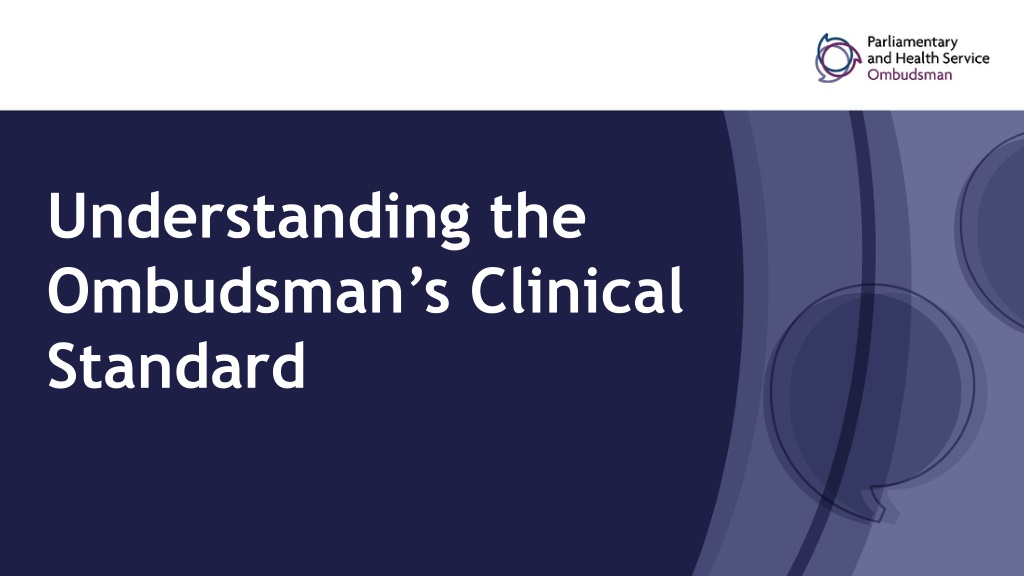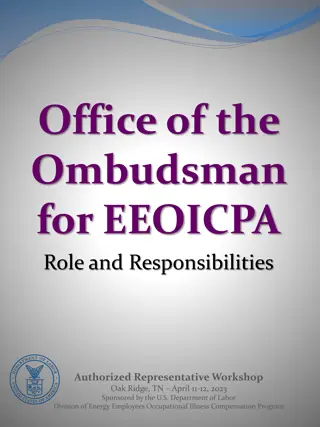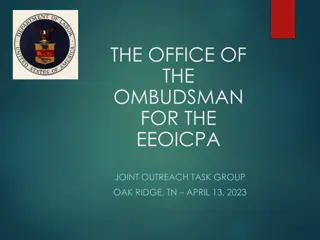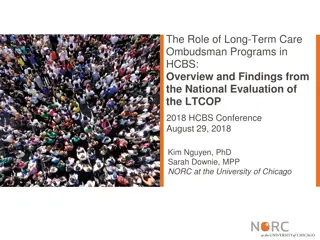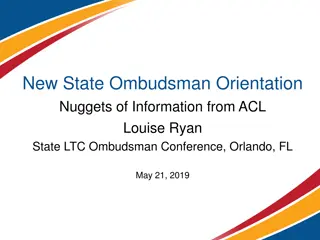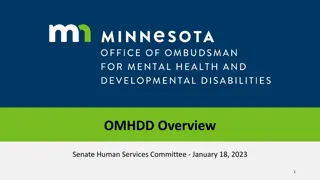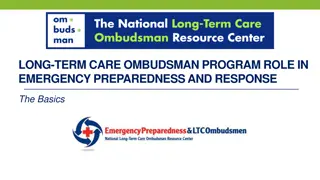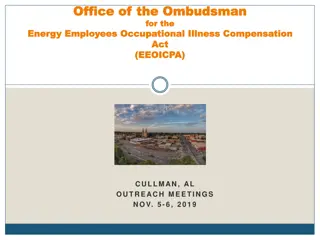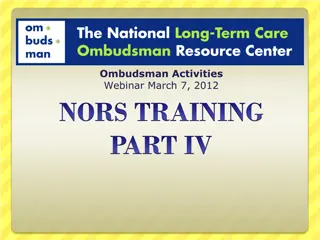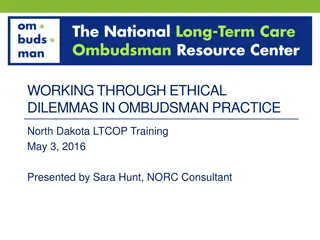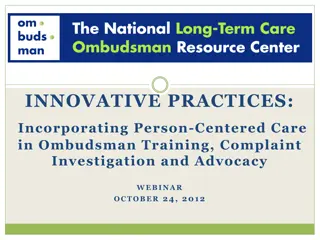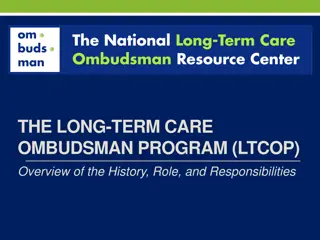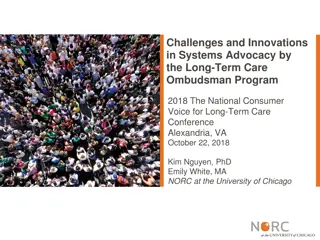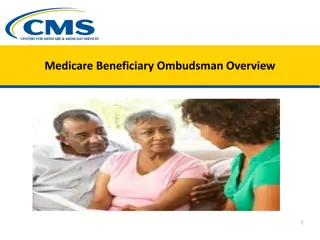Understanding the Ombudsman's Clinical Standard
The Ombudsman's Clinical Standard focuses on establishing good clinical care and treatment, using standards, guidance, and scientific evidence to improve public services. Through local investigations, the goal is to ensure decision-making transparency and sensitivity to patients' needs. Case studies illustrate the importance of following relevant guidelines in healthcare practices.
Download Presentation

Please find below an Image/Link to download the presentation.
The content on the website is provided AS IS for your information and personal use only. It may not be sold, licensed, or shared on other websites without obtaining consent from the author. Download presentation by click this link. If you encounter any issues during the download, it is possible that the publisher has removed the file from their server.
E N D
Presentation Transcript
Understanding the Ombudsman s Clinical Standard
Overview Our role Our approach Case examples Good local response Your feedback and questions
The role of PHSO Parliamentary Commissioner Act 1967 Health Service Commissioners Act 1993 88% 12% Investigations about UK government departments and public organisations Investigations about the NHS in England 3
Our casework process Investigation Our approach (look to see if what happened was in keeping with relevant regulations, standards, policies, and published guidance.) Our decision (If it wasn t, we look to see how significant the shortfall is and what impact it has had and, if it has caused hardship or injustice, has that already been remedied by the organisation.)
The Ombudsmans Clinical Standard Focus on establishing what would have been good clinical care and treatment at the time Standards, guidance, pathways, policy, local procedures, protocols, scientific evidence Aim to drive improvements in public services Ensuring we give organisations an early opportunity to tell us what lay behind the clinical decision making
The local investigation Getting it right first time What people want in decision making A real opportunity to be heard and input into process before decision is made. To see how decisions are made via clear, understandable and transparent rules. For complaint handlers to show they re acting sensitively and impartially- by basing decisions on objective information and appropriate criteria.
Case study 1 Ms B is intolerant to Ibuprofen. She complains that a GP prescribed her Naproxen for her hand pain. She says this caused additional pain and stomach ulcers. Three weeks later she returned to the Practice and saw a different GP who prescribed her Codeine. Following this her symptoms gradually resolved over 3 months.
Case study 1- relevant guidance NICE Clinical Knowledge Summaries section on NSAIDs; - prescribing issues. Good Practice in Prescribing and Managing Medicines and Devices para 24 You should reach agreement with the patient on the treatment proposed explaining: a) the likely benefits, risks and burdens, including serious and common side effects b) what to do in the event of a side effect or recurrence of the condition.
Case study 1- outcome Ms B was prescribed an appropriate alternate NSAID and given appropriate advice about the risks. Ms B was low risk for developing stomach damage due to taking an NSAID a PPI was not needed. The GP Practice provided a clear response explaining the rationale for the clinical decision making and offered a meeting with the patient.
Case study 2 Mr N attended the practice on a number of occasions with depression and anxiety. In January he attend an appointment saying he was nervous about an upcoming dental appointment. From that point until April he complains he was prescribed Diazepam by different doctors without a warning that he could become addicted and no advice about when to stop taking it. He was prescribed 84 tablets over a 3 month period.
Case study 2- relevant guidance NICE Guidance (Clinical knowledge summaries on generalised anxiety disorder) says: "Prescribe the lowest possible dose for the shortest period of time and review the patient regularly. Treatment should not exceed 2 4 weeks British National Formulary (BNF) 2 guidance says to avoid prolonged use.
Case study 2- outcome Mr N received care from a number of clinicians, with no one clinician taking responsibility for him. Diazepam was not prescribed in line with the relevant guidance. As a result of the complaint the Practice asked Mr N to make an appointment to discuss his symptoms and concerns. The Practice changed its prescribing practice as a result of this complaint.
Case study 3 Mr E attended the Practice and described a history of three instances of red stained urine in the previous 12 months. A GP decided against a urology referral at that time. He did not do a dip urine test. Instead, his plan was to wait and see; to check the PSA (a standard test to look for signs of prostate cancer) and to take and test a urine sample if Mr E had red stained urine again. Mr E returned to the Practice and a different GP performed a dip urine test which was positive for blood. He made a referral to urology. Mr E s son complained that the delay in referral impacted on his father s chances of survival.
Case study 3- relevant guidance NICE CG 27 Referral Guidelines for Suspected Cancer (2005, revised 2015) says: Male or female adult patients of any age who present with painless macroscopic haematuria should be referred urgently In patients aged 50 years and older who are found to have unexplained microscopic haematuria, an urgent referral should be made.
Case study 3- outcome Mr E met the criteria for urgent referral on his first attendance The Practice said Our GPs follow National guidelines (NICE guidelines) when patients present with frank haematuria, and these are in adherence with services provided by our local urology services, and referrals are in accordance with a two week rule referral policy . The Practice should have acknowledged that the guidance was not followed at the first appointment
The local investigation Getting it right first time Has the complaint been handled in line with: NHS Complaints Regulations Ombudsman s Principles of Good Complaint Handling Ombudsman s Principles for Remedy Local policy and procedures
Sharing learning Good local response Response should set out: The issues raised and what the complainant wants to achieve How you have investigated and the evidence considered including: the complainant s evidence staff/witness statements relevant extracts from clinical records independent clinical opinion
Sharing learning Good local response Explanation of whether or not something went wrong, by setting out: what happened - with reference to the evidence what should have happened - quoting relevant regulations, standards, policies, or published guidance and if they were met Your view of care/service provided in appropriate, clear, empathetic language If there is a shortfall (between what happened and what should have happened) an explanation of the shortfall and the impact it has had
Sharing learning Good local response If failings have caused injustice or hardship suitable apology and redress If appropriate, explain how it will be put right for other service users Explain how the complainant will be updated/involved in the changes Signpost to the Ombudsman service
Thank you Website www.ombudsman.org.uk @PHSOmbudsman Helpline 0345 015 4033 8.30am - 5.30pm Monday to Friday Parliamentary and Health Service Ombudsman E-mail liaisonmanagers@ombudsman.org.uk Radio Ombudsman Podcast
